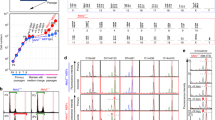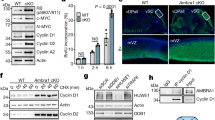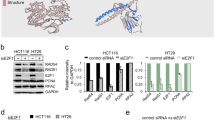Abstract
Defective DNA replication can result in genomic instability, cancer and developmental defects. To understand the roles of DNA damage response (DDR) genes on carcinogenesis in mutants defective for core DNA replication components, we utilized the Mcm4Chaos3/Chaos3 (‘Chaos3’) mouse model that, by virtue of an amino-acid alteration in MCM4 that destabilizes the MCM2-7 DNA replicative helicase, has fewer dormant replication origins and an increased number of stalled replication forks. This leads to genomic instability and cancer in most Chaos3 mice. We found that animals doubly mutant for Chaos3 and components of the ataxia telangiectasia-mutated (ATM) double-strand break response pathway (Atm, p21/Cdkn1a and Chk2/Chek2) had decreased tumor latency and/or increased tumor susceptibility. Tumor latency and susceptibility differed between genetic backgrounds and genders, with females demonstrating an overall greater cancer susceptibility to Atm and p21 deficiency than males. Atm deficiency was semilethal in the Chaos3 background and impaired embryonic fibroblast proliferation, suggesting that ATM drug inhibitors might be useful against tumors with DNA replication defects. Hypomorphism for the 9–1–1 component Hus1 did not affect tumor latency or susceptibility in Chaos3 animals, and tumors in these mice did not exhibit impaired ATR pathway signaling. These and other data indicate that under conditions of systemic replication stress, the ATM pathway is particularly important both for cancer suppression and viability during development.
This is a preview of subscription content, access via your institution
Access options
Subscribe to this journal
Receive 50 print issues and online access
$259.00 per year
only $5.18 per issue
Buy this article
- Purchase on Springer Link
- Instant access to full article PDF
Prices may be subject to local taxes which are calculated during checkout




Similar content being viewed by others
References
TCGA, Comprehensive genomic characterization defines human glioblastoma genes and core pathways. Nature 2008; 455: 1061–1068.
TCGA, Integrated genomic analyses of ovarian carcinoma. Nature 2011; 474: 609–615.
Wood LD, Parsons DW, Jones S, Lin J, Sjoblom T, Leary RJ et al. The genomic landscapes of human breast and colorectal cancers. Science 2007; 318: 1108–1113.
TCGA, Comprehensive molecular portraits of human breast tumours. Nature 2012; 490: 61–70.
Moynahan ME, Jasin M . Mitotic homologous recombination maintains genomic stability and suppresses tumorigenesis. Nat Rev Mol Cell Biol 2010; 11: 196–207.
Polo SE, Jackson SP . Dynamics of DNA damage response proteins at DNA breaks: a focus on protein modifications. Genes Dev 2011; 25: 409–433.
Warmerdam DO, Kanaar R . Dealing with DNA damage: relationships between checkpoint and repair pathways. Mutat Res 2009; 704: 2–11.
Cortez D, Glick G, Elledge SJ . Minichromosome maintenance proteins are direct targets of the ATM and ATR checkpoint kinases. Proc Natl Acad Sci USA 2004; 101: 10078–10083.
Shechter D, Gautier J . MCM proteins and checkpoint kinases get together at the fork. Proc Natl Acad Sci USA 2004; 101: 10845–10846.
Preston BD, Albertson TM, Herr AJ . DNA replication fidelity and cancer. Semin Cancer Biol 2010; 20: 281–293.
Albertson TM, Ogawa M, Bugni JM, Hays LE, Chen Y, Wang Y et al. DNA polymerase epsilon and delta proofreading suppress discrete mutator and cancer phenotypes in mice. Proc Natl Acad Sci USA 2009; 106: 17101–17104.
Goldsby RE, Lawrence NA, Hays LE, Olmsted EA, Chen X, Singh M et al. Defective DNA polymerase-delta proofreading causes cancer susceptibility in mice. Nat Med 2001; 7: 638–639.
Arana ME, Kunkel TA . Mutator phenotypes due to DNA replication infidelity. Semin Cancer Biol 2010; 20: 304–311.
TCGA, Comprehensive molecular characterization of human colon and rectal cancer. Nature 2012; 487: 330–337.
Sclafani RA, Holzen TM . Cell cycle regulation of DNA replication. Annu Rev Genet 2007; 41: 237–280.
Ilves I, Petojevic T, Pesavento JJ, Botchan MR . Activation of the MCM2–7 helicase by association with Cdc45 and GINS proteins. Mol Cell 2010; 37: 247–258.
Moyer SE, Lewis PW, Botchan MR . Isolation of the Cdc45/Mcm2–7/GINS (CMG) complex, a candidate for the eukaryotic DNA replication fork helicase. Proc Natl Acad Sci USA 2006; 103: 10236–10241.
Vijayraghavan S, Schwacha A . The eukaryotic mcm2–7 replicative helicase. Subcell Biochem 2012; 62: 113–134.
Shima N, Alcaraz A, Liachko I, Buske TR, Andrews CA, Munroe RJ et al. A viable allele of Mcm4 causes chromosome instability and mammary adenocarcinomas in mice. Nat Genet 2007; 39: 93–98.
Pruitt SC, Bailey KJ, Freeland A . Reduced Mcm2 expression results in severe stem/progenitor cell deficiency and cancer. Stem Cells 2007; 25: 3121–3132.
Bagley BN, Keane TM, Maklakova VI, Marshall JG, Lester RA, Cancel MM et al. A dominantly acting murine allele of mcm4 causes chromosomal abnormalities and promotes tumorigenesis. PLoS Genet 2012; 8: e1003034.
Honeycutt KA, Chen Z, Koster MI, Miers M, Nuchtern J, Hicks J et al. Deregulated minichromosomal maintenance protein MCM7 contributes to oncogene driven tumorigenesis. Oncogene 2006; 25: 4027–4032.
Kunnev D, Rusiniak ME, Kudla A, Freeland A, Cady GK, Pruitt SC . DNA damage response and tumorigenesis in Mcm2-deficient mice. Oncogene 2010; 29: 3630–3638.
Chuang CH, Wallace MD, Abratte C, Southard T, Schimenti JC . Incremental genetic perturbations to MCM2–7 expression and subcellular distribution reveal exquisite sensitivity of mice to DNA replication stress. PLoS Genet 2010; 6: e1001110.
Kawabata T, Luebben SW, Yamaguchi S, Ilves I, Matise I, Buske T et al. Stalled fork rescue via dormant replication origins in unchallenged S phase promotes proper chromosome segregation and tumor suppression. Mol Cell 2011; 41: 543–553.
Chuang CH, Yang D, Bai G, Freeland A, Pruitt SC, Schimenti JC . Post-transcriptional homeostasis and regulation of MCM2–7 in mammalian cells. Nucleic Acids Res 2012; 40: 4914–4924.
Li XC, Tye BK . Ploidy dictates repair pathway choice under DNA replication stress. Genetics 2011; 187: 1031–1040.
Kawabata T, Yamaguchi S, Buske T, Luebben SW, Wallace M, Matise I et al. A reduction of licensed origins reveals strain-specific replication dynamics in mice. Mamm Genome 2011; 22: 506–517.
Cimprich KA, Cortez D . ATR: an essential regulator of genome integrity. Nat Rev Mol Cell Biol 2008; 9: 616–627.
Jones RM, Petermann E . Replication fork dynamics and the DNA damage response. Biochem J 2012; 443: 13–26.
Errico A, Costanzo V . Mechanisms of replication fork protection: a safeguard for genome stability. Crit Rev Biochem Mol Biol 2012; 47: 222–235.
Wallace MD, Pfefferle AD, Shen L, McNairn AJ, Cerami EG, Fallon BL et al. Comparative oncogenomics implicates the Neurofibromin 1 gene (NF1) as a breast cancer driver. Genetics 2012; 192: 385–396.
Bhatti S, Kozlov S, Farooqi AA, Naqi A, Lavin M, Khanna KK . ATM protein kinase: the linchpin of cellular defenses to stress. Cell Mol Life Sci 2011; 68: 2977–3006.
Barlow C, Hirotsune S, Paylor R, Liyanage M, Eckhaus M, Collins F et al. Atm-deficient mice: a paradigm of ataxia telangiectasia. Cell 1996; 86: 159–171.
Reiman A, Srinivasan V, Barone G, Last JI, Wootton LL, Davies EG et al. Lymphoid tumours and breast cancer in ataxia telangiectasia; substantial protective effect of residual ATM kinase activity against childhood tumours. Br J Cancer 2011; 105: 586–591.
Elson A, Wang Y, Daugherty CJ, Morton CC, Zhou F, Campos-Torres J et al. Pleiotropic defects in ataxia–telangiectasia protein-deficient mice. Proc Natl Acad Sci USA 1996; 93: 13084–13089.
Xu Y, Ashley T, Brainerd EE, Bronson RT, Meyn MS, Baltimore D . Targeted disruption of ATM leads to growth retardation, chromosomal fragmentation during meiosis, immune defects, and thymic lymphoma. Genes Dev 1996; 10: 2411–2422.
Spring K, Ahangari F, Scott SP, Waring P, Purdie DM, Chen PC et al. Mice heterozygous for mutation in Atm, the gene involved in ataxia–telangiectasia, have heightened susceptibility to cancer. Nat Genet 2002; 32: 185–190.
Mao JH, Wu D, DelRosario R, Castellanos A, Balmain A, Perez-Losada J . Atm heterozygosity does not increase tumor susceptibility to ionizing radiation alone or in a p53 heterozygous background. Oncogene 2008; 27: 6596–6600.
Lu S, Shen K, Wang Y, Santner SJ, Chen J, Brooks SC et al. Atm-haploinsufficiency enhances susceptibility to carcinogen-induced mammary tumors. Carcinogenesis 2006; 27: 848–855.
Karabinis ME, Larson D, Barlow C, Wynshaw-Boris A, Moser AR . Heterozygosity for a mutation in Brca1 or Atm does not increase susceptibility to ENU-induced mammary tumors in Apc(Min)/+ mice. Carcinogenesis 2001; 22: 343–346.
Bartek J, J Lukas . Chk1 and Chk2 kinases in checkpoint control and cancer. Cancer Cell 2003; 3: 421–429.
Pabla N, Huang S, Mi QS, Daniel R, Dong Z . ATR-Chk2 signaling in p53 activation and DNA damage response during cisplatin-induced apoptosis. J Biol Chem 2008; 283: 6572–6583.
Matsuoka S, Rotman G, Ogawa A, Shiloh Y, Tamai K, Elledge SJ . Ataxia telangiectasia-mutated phosphorylates Chk2 in vivo and in vitro. Proc Natl Acad Sci USA 2000; 97: 10389–10394.
Lee JS, Collins KM, Brown AL, Lee CH, Chung JH . hCds1-mediated phosphorylation of BRCA1 regulates the DNA damage response. Nature 2000; 404: 201–204.
Moynahan ME, Chiu JW, Koller BH, Jasin M . Brca1 controls homology-directed DNA repair. Mol Cell 1999; 4: 511–518.
Hirao A, Cheung A, Duncan G, Girard PM, Elia AJ, Wakeham A et al. Chk2 is a tumor suppressor that regulates apoptosis in both an ataxia telangiectasia mutated (ATM)-dependent and an ATM-independent manner. Mol Cell Biol 2002; 22: 6521–6532.
El GS, Pamidi A, Halaby MJ, Bohgaki M, Cardoso R, Li L et al. Inactivation of chk2 and mus81 leads to impaired lymphocytes development, reduced genomic instability, and suppression of cancer. PLoS Genet 2011; 7: e1001385.
Niida H, Murata K, Shimada M, Ogawa K, Ohta K, Suzuki K et al. Cooperative functions of Chk1 and Chk2 reduce tumour susceptibility in vivo. EMBO J 2010; 29: 3558–3570.
Stracker TH, Couto SS, Cordon-Cardo C, Matos T, Petrini JH . Chk2 suppresses the oncogenic potential of DNA replication-associated DNA damage. Mol Cell 2008; 31: 21–32.
Takai H, Naka K, Okada Y, Watanabe M, Harada N, Saito S et al. Chk2-deficient mice exhibit radioresistance and defective p53-mediated transcription. EMBO J 2002; 21: 5195–5205.
Kemp M, Sancar A . DNA distress: just ring 9–1–1. Curr Biol 2009; 19: R733–R734.
Levitt PS, Zhu M, Cassano A, Yazinski SA, Liu H, Darfler J et al. Genome maintenance defects in cultured cells and mice following partial inactivation of the essential cell cycle checkpoint gene Hus1. Mol Cell Biol 2007; 27: 2189–2201.
Shieh SY, Ikeda M, Taya Y, Prives C . DNA damage-induced phosphorylation of p53 alleviates inhibition by MDM2. Cell 1997; 91: 325–334.
Zhao H, Piwnica-Worms H . ATR-mediated checkpoint pathways regulate phosphorylation and activation of human Chk1. Mol Cell Biol 2001; 21: 4129–4139.
Balmus G, Zhu M, Mukherjee S, Lyndaker AM, Hume KR, Lee J et al. Disease severity in a mouse model of ataxia telangiectasia is modulated by the DNA damage checkpoint gene Hus1. Hum Mol Genet 2012; 21: 3408–3420.
Cazzalini O, Scovassi AI, Savio M, Stivala LA, Prosperi E . Multiple roles of the cell cycle inhibitor p21(CDKN1A) in the DNA damage response. Mutat Res 2010; 704: 12–20.
Deng C, Zhang P, Harper JW, Elledge SJ, Leder P . Mice lacking p21CIP1/WAF1 undergo normal development, but are defective in G1 checkpoint control. Cell 1995; 82: 675–684.
Halazonetis TD, Gorgoulis VG, Bartek J . An oncogene-induced DNA damage model for cancer development. Science 2008; 319: 1352–1355.
Bartkova J, Rezaei N, Liontos M, Karakaidos P, Kletsas D, Issaeva N et al. Oncogene-induced senescence is part of the tumorigenesis barrier imposed by DNA damage checkpoints. Nature 2006; 444: 633–637.
Barlow C, Eckhaus MA, Schaffer AA, Wynshaw-Boris A . Atm haploinsufficiency results in increased sensitivity to sublethal doses of ionizing radiation in mice. Nat Genet 1999; 21: 359–360.
Berger AH, Knudson AG, Pandolfi PP . A continuum model for tumour suppression. Nature 2011; 476: 163–169.
Thompson D, Duedal S, Kirner J, McGuffog L, Last J, Reiman A et al. Cancer risks and mortality in heterozygous ATM mutation carriers. J Natl Cancer Inst 2005; 97: 813–822.
Petermann E, Helleday T . Pathways of mammalian replication fork restart. Nat Rev Mol Cell Biol 2010; 11: 683–687.
Gatei M, Sloper K, Sorensen C, Syljuasen R, Falck J, Hobson K et al. Ataxia–telangiectasia-mutated (ATM) and NBS1-dependent phosphorylation of Chk1 on Ser-317 in response to ionizing radiation. J Biol Chem 2003; 278: 14806–14811.
Weiss RS, Matsuoka S, Elledge SJ, Leder P . Hus1 acts upstream of chk1 in a mammalian DNA damage response pathway. Curr Biol 2002; 12: 73–77.
Murga M, Campaner S, Lopez-Contreras AJ, Toledo LI, Soria R, Montana MF et al. Exploiting oncogene-induced replicative stress for the selective killing of Myc-driven tumors. Nat Struct Mol Biol 2011; 18: 1331–1335.
Schoppy DW, Ragland RL, Gilad O, Shastri N, Peters AA, Murga M et al. Oncogenic stress sensitizes murine cancers to hypomorphic suppression of ATR. J Clin Invest 2012; 122: 241–252.
Lopez-Contreras AJ, Fernandez-Capetillo O . The ATR barrier to replication-born DNA damage. DNA Repair (Amst) 2010; 9: 1249–1255.
Mokrani-Benhelli H, Gaillard L, Biasutto P, Le GT, Touzot F, Vasquez N et al. Primary microcephaly, impaired DNA replication, and genomic instability caused by compound heterozygous ATR mutations. Hum Mutat 2013; 34: 374–384.
Lieberman HB, Bernstock JD, Broustas CG, Hopkins KM, Leloup C, Zhu A . The role of RAD9 in tumorigenesis. J Mol Cell Biol 2011; 3: 39–43.
Murga M, Bunting S, Montana MF, Soria R, Mulero F, Canamero M et al. A mouse model of ATR-Seckel shows embryonic replicative stress and accelerated aging. Nat Genet 2009; 41: 891–898.
Meijers-Heijboer H, van den Ouweland A, Klijn J, Wasielewski M, de Snoo A, Oldenburg R et al. Low-penetrance susceptibility to breast cancer due to CHEK2(*)1100delC in noncarriers of BRCA1 or BRCA2 mutations. Nat Genet 2002; 31: 55–59.
Dorak MT, Karpuzoglu E . Gender differences in cancer susceptibility: an inadequately addressed issue. Front Genet 2012; 3: 268.
Zheng YL, Kosti O, Loffredo CA, Bowman E, Mechanic L, Perlmutter D et al. Elevated lung cancer risk is associated with deficiencies in cell cycle checkpoints: genotype and phenotype analyses from a case–control study. Int J Cancer 2010; 126: 2199–2210.
Curtin NJ . DNA repair dysregulation from cancer driver to therapeutic target. Nat Rev Cancer 2012; 12: 801–817.
Levitt PS, Liu H, Manning C, Weiss RS . Conditional inactivation of the mouse Hus1 cell cycle checkpoint gene. Genomics 2005; 86: 212–224.
Weiss RS, Enoch T, Leder P . Inactivation of mouse Hus1 results in genomic instability and impaired responses to genotoxic stress. Genes Dev 2000; 14: 1886–1898.
Hirao A, Kong YY, Matsuoka S, Wakeham A, Ruland J, Yoshida H et al. DNA damage-induced activation of p53 by the checkpoint kinase Chk2. Science 2000; 287: 1824–1827.
Acknowledgements
We thank RS Weiss and T Mak for providing mice. We also thank RS Weiss and G Balmus for critical feedback on the manuscript. This study was supported by NIH Training Grants IT32HDO57854 and 5T32GM007617, and Empire State Stem Cell Fund Contract Numbers C026442 and C024174 to JCS.
Author information
Authors and Affiliations
Corresponding author
Ethics declarations
Competing interests
The authors declare no conflict of interest.
Additional information
Supplementary Information accompanies this paper on the Oncogene website
Rights and permissions
About this article
Cite this article
Wallace, M., Southard, T., Schimenti, K. et al. Role of DNA damage response pathways in preventing carcinogenesis caused by intrinsic replication stress. Oncogene 33, 3688–3695 (2014). https://doi.org/10.1038/onc.2013.339
Received:
Revised:
Accepted:
Published:
Issue Date:
DOI: https://doi.org/10.1038/onc.2013.339
Keywords
This article is cited by
-
The tumor suppressor Hic1 maintains chromosomal stability independent of Tp53
Oncogene (2018)
-
Inflammation, a significant player of Ataxia–Telangiectasia pathogenesis?
Inflammation Research (2018)
-
DNA damage and the balance between survival and death in cancer biology
Nature Reviews Cancer (2016)



